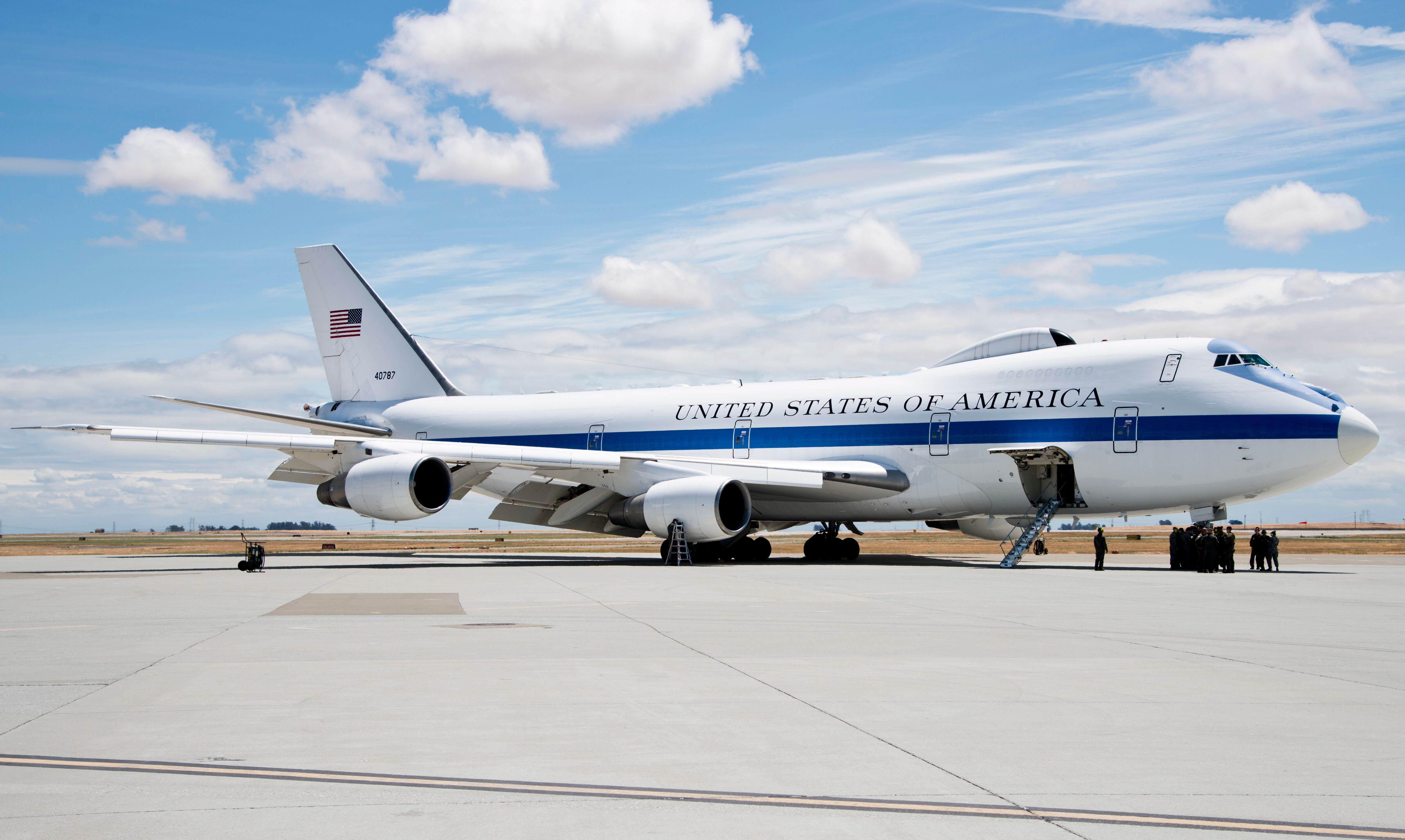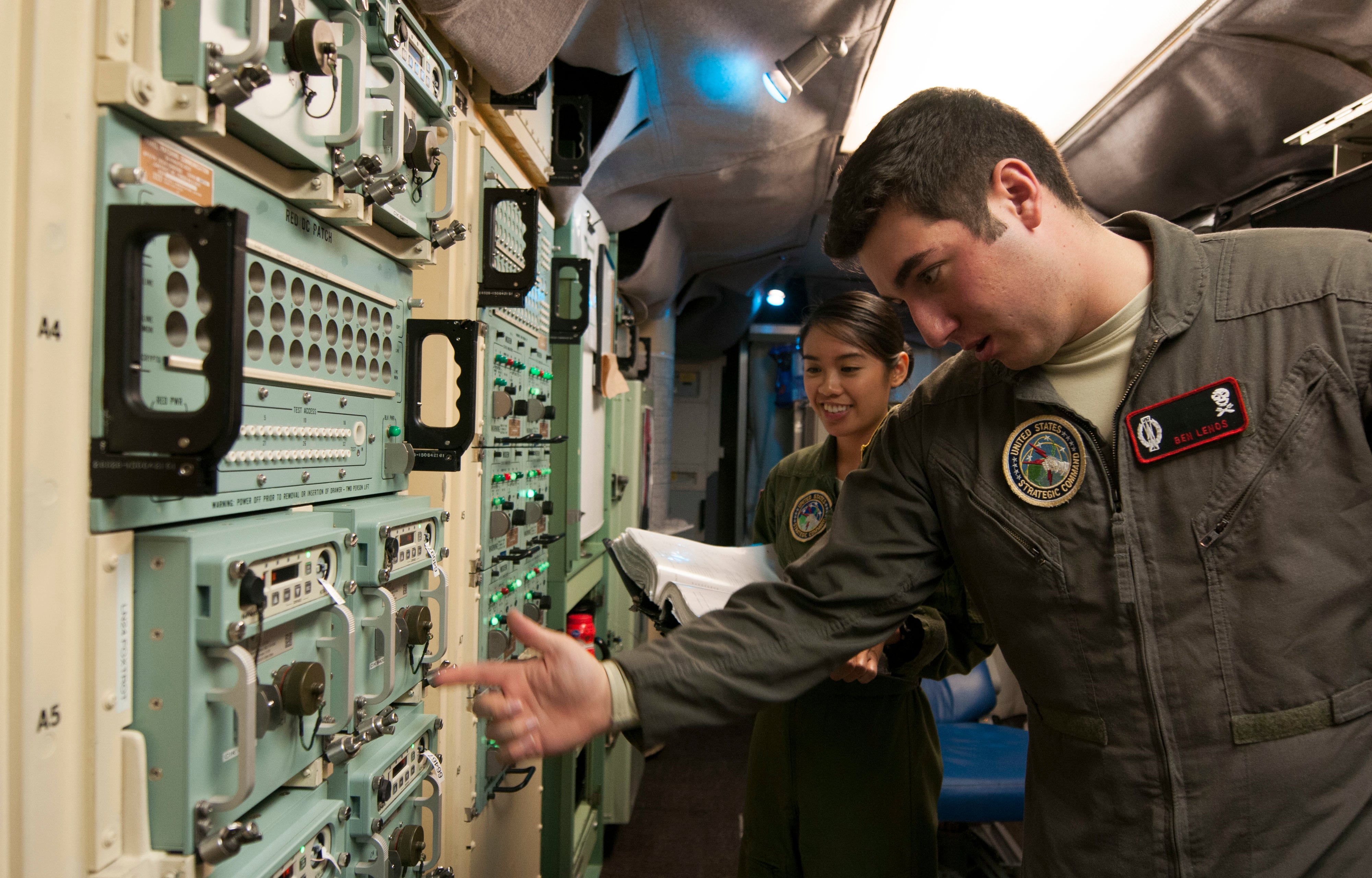OFFUTT AIR FORCE BASE, Neb. — Earlier this year, the sole hangar for the E-4B Nightwatch airborne command post at Offutt Air Force Base was submerged in water after floods hit Omaha, Nebraska.
Months later, the hangar is now usable but not fully operational, creating a challenge for the maintainers charged with keeping the E-4B ready to fly.
Nicknamed the “Doomsday plane” due to its ability to withstand a nuclear blast, the iconic blue and white E-4B serves two purposes: to provide a secure and survivable command center in the event of a nuclear war and — until recently — to transport defense secretaries around the world.
The U.S. Air Force only operates four E-4Bs, all based at Offutt, and at least one of those aircraft must be on alert 24/7 year-round. As one E-4B is usually going through a yearlong depot maintenance period and another is typically receiving modifications, two aircraft are left to fulfill mission requirements. But because of the high number of maintenance activities currently ongoing, the Air Force has temporarily stopped using its E-4Bs for VIP transport , Defense One reported earlier in November.
RELATED

The flood has made it difficult to keep at least one those planes functional, said Maj. James Hodges, who leads the 595th Aircraft Maintenance Squadron.
Hodges arrived at Offutt on March 18, during the period when the flood hit the base, causing what may add up to $1 billion in damage, according to the Omaha World Herald.
“There’s a beautiful change-of-command photo with the hangar underwater in the background," he joked during an October interview.
The 595th AMXS was able to move its equipment and tools to the north side of the base before the flood covered some parts of Offutt in up to 8 feet of water. None of the Nightwatch planes were damaged by the flood, but in the immediate aftermath of the disaster, the squadron was displaced, often having to fly to Wright-Patterson Air Force Base in Ohio to conduct heavy maintenance.

Now, half a year later, maintainers are back at work repairing E-4B aircraft at Offutt, including changing out engines and performing most of the heavy maintenance, Hodges said.
“We do what we can on the ramp. Now the flood waters have receded, so while the buildings still need some work as far as repairing electrical stuff, [the hangar] still works as some overall cover,” he said. “We're probably, I'd say, about 50 percent capable with that facility now.”
But the hangar isn’t yet fit for all maintenance work. Tasks requiring a temperature-controlled environment — like isochronal inspections that occur every 220 days, take 24 days to complete, and require personnel to crawl through the jet and inspect wires, re-lube components and wash the aircraft — must still be done at Wright-Patterson.
“It just makes the scheduling more important,” Hodges said. “Because when it’s time to do that inspection, we’ll send up to about 60 guys … to Wright-Patterson Air Force Base with the jet to do that inspection. So while those 60 bodies are there, I have 60 less bodies here to do day-to-day care and feeding.”
The 595th AMXS is comprised of 260 personnel, but 40 of those are either permanently located at Wright-Patterson or focused on scheduling, leaving a core cadre of 220 maintainers. Transferring more than a quarter of them to Ohio for weeks at a time adds another layer of difficulty to an already complicated task. Furthermore, the squadron is already undermanned and lacks the optimal number of experienced maintainers.
But the Air Force is taking steps to correct the situation, Hodges said. After a study found that the 595th AMXS was short by 130 maintainers, 30 were added to the squadron during this summer.
"While that helped bolster the numbers, those 30 bodies have to be trained,” he said, adding that it takes six months to qualify a trained maintainer on the E-4B and another year for them to gain the experience necessary to know the plane.
Meanwhile, the funding to hire the remaining 100 maintainers needed is unavailable, but Hodges hopes that gap will be filled by 2021.

The future of the E-4B
The E-4B was introduced in 1974, and a replacement for the Boeing 747 derivative is still years, perhaps decades, into the future.
In 2018, the Defense Department released a solicitation signaling its interest in recapitalizing the E-4B, E-6B and C-32A platforms and asking industry for information. The NEAT program could replace all three aircraft types with a common airframe or family of planes. NEAT is short for the military’s name for the missions conducted by those platforms: National Airborne Operations Center (NAOC), Executive Airlift, Airborne Command Post (ABNCP), and Take Charge and Move Out (TACAMO).
RELATED

An industry day was held in April, however it’s unclear if the effort will materialize into a program of record.
In the meantime, the Air Force is pressing forward with key upgrades for its E-4B fleet, setting aside about $176 million in its fiscal 2020 budget for “enhancements to aircraft structures, [the] propulsion system, fuel system, environmental control system, electrical generation and distribution systems, flight safety and navigation systems” as well as modifications needed to meet Federal Aviation Administration requirements.
Some of the modifications underway or planned include integrating the advanced extremely high-frequency terminal, the low-frequency transmit system and the Mobile User Objective System, as well as technologies necessary to upgrade presidential voice conferencing, according to budget documents.
While the bones of the E-4B are decades old, many of communication and navigation systems have been added or modernized over the years, resulting in a hodgepodge of different equipment that must be mastered by maintainers.
“Typically on a regular jet … we have, let’s say, 20-something odd systems that we have to manage or maintain. But now we have something like 113. So it’s a bit of a steep learning curve because it’s not stuff we’re taught [at tech school]. We have to learn it while we’re here,” said Tech. Sgt. Elden Magnuson, one of the squadron’s approximately 50 communications and navigation specialists.
It takes years to build up expertise on so many systems, so the 595th AMXS tends to retain its maintainers longer than most other squadrons. For example, Magnuson — who previously worked on C-130s and C-17s — has clocked in eight years as an E-4B maintainer.
But every day is a challenge, he said, because new systems are continually added to the aircraft. For instance, when Defense News visited Offutt Air Force Base in October, the Air Force had begun flight tests of a new antenna that trails behind the E-4B.
“One of the challenges we’ve met is when a system comes onboard faster than we are trained to [maintain] it,” he said. That’s part of why the squadron retains such a large number of communication and navigation specialists — to allow the squadron to constantly cycle maintainers through training.
“We’ve done a pretty good job with that," he said.
Valerie Insinna is Defense News' air warfare reporter. She previously worked the Navy/congressional beats for Defense Daily, which followed almost three years as a staff writer for National Defense Magazine. Prior to that, she worked as an editorial assistant for the Tokyo Shimbun’s Washington bureau.






